Taxonomy
The family Brachioteuthidae was fully described by Pfeffer in 1908, with its first species, Brachioteuthisbeanii, originally identified by A.E. Verrill in 1881 from two specimens collected off the coast of Martha's Vineyard. However, the species was described based on a heavily damaged individual, which made its classification more challenging. Initially, B. beanii was considered a potential member of the family Chiroteuthidae due to the neck-like feature observed in its paralarvae, but further examination revealed several key differences that warranted its placement in Brachioteuthidae instead.
In 1882, Steenstrup described a new genus, Tracheloteuthis (later synonymized with Brachioteuthis), along with two new species: T. riisei (=B. riisei) and T. behnii (=B. behnii). These species were primarily based on paralarval forms, with very little morphological detail provided, and additional research was needed, particularly to confirm the validity of B. behnii.
In 1908, another species, B. bowmani, was discovered by E.S. Russel. This species, known only from a single female specimen measuring about 61 mm in mantle length from the northeast Atlantic, remains poorly understood due to the loss of the type specimen, limiting further study of its validity.
In 1910, Carl Chun described B. picta, based on a nearly perfect mature specimen collected in the Benguela Current off the coast of Africa. Chun's description highlighted several distinguishing features, including a long, bluntly pointed mantle, fins about half the length of the mantle, a head slightly larger than the mantle, and a wide club with a curved apex, which set B. picta apart from other species in the genus.
The 21st century saw further advancements in Brachioteuthis taxonomy, with Marek Lipinski's 2001 description of B. linkovskyi and the new genus Slosarczykovia with the species (S. circumantarctica). B. linkovskyi was described from a single male specimen, notable for its reticulate, wart-covered mantle (with no warts on the head, fins, or arms), fins extending into the tail, and relatively short arms. The species also featured suckers with 9-12 teeth on each arm, and a lack of sexual `modification in arms IV, including no hectocotylus. The largest suckers on the manus had up to 14 long, sharp teeth, and those on the proximal dactylus were 2.5–4 times larger than those on the manus.
Slosarczykovia, a new genus described in the same work, was distinguished by the presence of a fibrous net in both males and females, a weakly differentiated suckered club, and the absence of a carpal fixing apparatus. The largest suckers on the proximal manus were about 33% larger than those on the proximal dactylus.
Despite a lack of significant morphological similarities, Discoteuthidae is considered the sister group to Brachioteuthidae, a relationship that remains somewhat enigmatic, given the few shared traits between the two families.
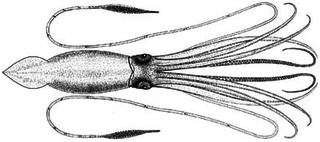
The giant squid is a species of deep-ocean dwelling squid in the family Architeuthidae. It can grow to a tremendous size, offering an example of abyssal gigantism: recent estimates put the maximum size at around 12–13 m (39–43 ft) for females and 10 m (33 ft) for males, from the posterior fins to the tip of the two long tentacles. The mantle of the giant squid is about 2 m long, and the length of the squid excluding its tentacles rarely exceeds 5 m (16 ft). Claims of specimens measuring 20 m (66 ft) or more have not been scientifically documented.

Bathyteuthis is the singular genus of squid in the family Bathyteuthidae, encompassing three species.

Brachioteuthis is a genus of squid comprising six species.
The Chiroteuthidae are a family of deep-sea squid, generally small to medium in size, rather soft and gelatinous, and slow moving. They are found in most temperate and tropical oceans, but are known primarily from the North Atlantic, North Pacific, and Indo-Pacific. The family is represented by approximately 12 species and four subspecies in four genera, two of which are monotypic. They are sometimes known collectively as whip-lash squid, but this common name is also applied to the Mastigoteuthidae, which are sometimes treated as a subfamily (Mastigoteuthinae) of Chiroteuthidae.

The Mastigoteuthidae, also known as whip-lash squid, are a family of small deep-sea squid. Approximately 20 known species in six genera are represented, with members found in both the mesopelagic and bathypelagic zone of most oceans. Originally described by Verill in 1881, it was later lowered by Chun (1920) to a subfamily (Mastigoteuthinae) of the Chiroteuthidae. However, Roper et al. (1969) raised it back to the family level, and this has not been changed since. The taxonomy of this family is extremely unstable, and there have been at times one genus, two genera and four subgenera(Salcedo-Vargas & Okutani, 1994), two genera and several 'groups', five genera and one species with an uncertain placement, or six genera.

Ommastrephidae is a family of squid containing three subfamilies, 11 genera, and over 20 species. They are widely distributed globally and are extensively fished for food. One species, Todarodes pacificus, comprised around half of the world's cephalopod catch annually.
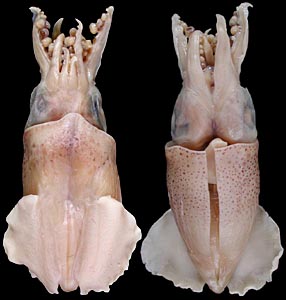
A. aldrichi is a small species of squid found in northern Australian waters. The species was described by Chung Cheng Lu in 2005 based on specimens collected in the inshore waters of Northern Australia. The largest known individual of this species is a mature female measuring 27.6 mm (1.09 in) in mantle length (ML). The holotype is a mature male of 21.3 mm (0.84 in) ML. A live specimen of A. aldrichi has yet to be recorded.
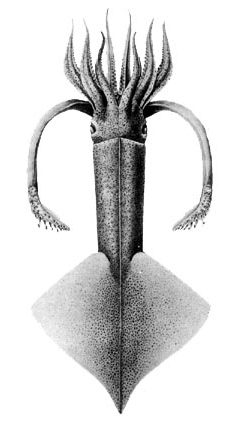
Onychoteuthis is a genus of squid in the family Onychoteuthidae. The type species is Onychoteuthis bergii. While the genus is found worldwide in tropical and subtropical oceans, they can also occur in the North Pacific Ocean. There were previously considered to be four species in the genus but there are now considered to be roughly 10. These squid are frequently observed in the surface waters at night and they are often caught using dipnet at nightlight stations. The young squid are usually the only specimens captured using standard midwater trawls, the older squid are apparently able to avoid the trawls. They can, however be collected from the air as individuals are able to leap high out of the water, sometimes even landing on the deck of a ship.

Illex coindetii, commonly known as the southern shortfin squid or broadtail shortfin squid, is a species of neritic squids in the family Ommastrephidae. They are found in the Mediterranean Sea and on both sides of the north Atlantic Ocean.

Teuthowenia megalops, sometimes known as the Atlantic cranch squid, is a species of glass squid from the subarctic and temperate waters of the northern Atlantic Ocean. They are moderately sized squid with a maximum mantle length of 40 cm (16 in). Their very large eyes are the source for the specific name megalops. Like other members of the genus Teuthowenia, they are easily recognizable by the presence of three bioluminescent organs (photophores) on their eyeballs.

Cephalopods exhibit various dermal structures on their mantles and other parts. These may take the form of conspicuous warts, cushions, papillae or scales, though in many species they are microscopic tubercles. The most elaborate forms are found among the oceanic squid of the order Teuthida.
Brachioteuthis riisei is a species of squid in the family Brachioteuthidae.

Slosarczykovia is a monotypic genus of squid, its sole representative being Slosarczykovia circumantarctica. Slosarczykovia is placed in the family Brachioteuthidae.

Taonius belone is a glass squid belonging to the genus Taonius from the family Cranchiidae. It occurs in the northern subtropical and in the tropical or equatorial waters of the Pacific Ocean and the Indian Ocean.
Gonatopsis okutanii is a species of squid from the family Gonatidae from the northern Pacific Ocean. It is of uncertain taxonomic status, the presence of remnant tentacles on spent females indicate that this species does not belong in the genus Gonatopsis and the differences between this species and Gonatus makodai have led to some authorities stating that G. okutanii is a junior synonym of Eogonatus tinro. However the World Register of Marine Species still recognises Gonatopsis okutanii as the valid name for this taxon.
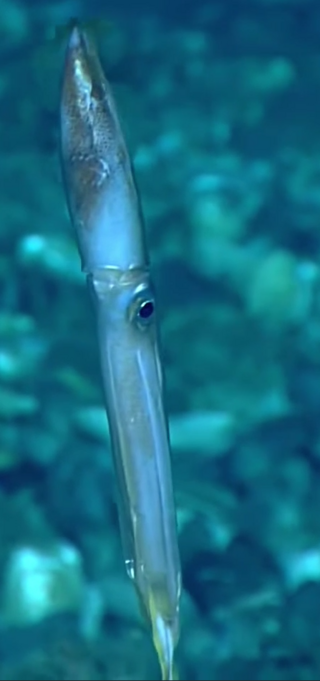
Neoteuthis is a monotypic genus of squid, the sole member is Neoteuthis thielei, from the family Neoteuthidae. This species has long tentacular clubs measuring 60% of the mantle length and fins which are 70% of its mantle length. It has a proximal locking-apparatus for the club which is restricted to manus, which in turn has proximal suckers which are circular. It has been recorded from the South Atlantic Ocean, North Atlantic Ocean, near the Canary Islands and North Pacific Ocean, north of Hawaii. The paralarvae and juveniles are found in the epipelagic to mesopelagic zones while adults occur in the mesopelagic to bathypelagic zones.
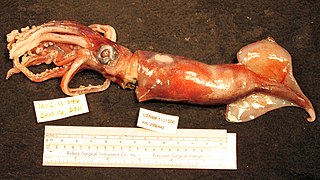
Ornithoteuthis antillarum, the Atlantic bird squid, is a species of flying squid from the family Ommastrephidae which is found in the warmer waters of the Atlantic Ocean. This species is an important component of the diet of many species of fish and of cetaceans. It is taken as a bycatch in fisheries but has the potential to be commercially important if appropriate fishing methods can be developed.
Ornithoteuthis volatilis, the shiny bird squid, is a squid from the subfamily Ommastrephinae, the flying squids, of the family Ommastrephidae part of the pelagic squid order Oegopsida. It is a tropical and sub-tropical species which is widely distributed in the Indo-Pacific oceans. It is slightly larger than the closely related species Ornithoteuthis antillarum of the Atlantic Ocean.
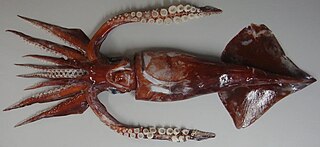
The Antarctic flying squid is a species of squid from the subfamily Todarodinae of the family Ommastrephidae, a family of pelagic squid from the order Oegopsida. It has a circumglobal distribution in the seas around the lower latitudes of the Southern Ocean.
The little flying squid is a species of squid, one of the arrow squids of the genus Todarodes, in the subfamily Todarodinae of the flying squid family Ommastrephidae. It is a small species from the waters around northern Australia and Indonesia.















